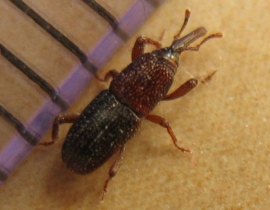Professional Pest Control & Wildlife Management
Grain Weevils
Grain Weevils Sitophilus granarius are quite common, exceptional breeding rates make this a serious pest on wheat and barley but it can also be found in the home on hard ceral products such as pasta.
These guys have the typical weevil snout which they use to feed and bore holes into grains to lay eggs. Grain weevils are slightly bigger than the rice weevil and grow to 4mm.
They tend to avoid direct sunlight and if handled these insects feign death.
-
Risks
With such prolific breeding rates Grain Weevils can potentially damage vast quantities of stored product. As most of the life cycle is completed within the grains an infestation may go unnoticed for a short while causing significant damage.
Fortunately weevils require grain with a moisture content above 9.5% to breed successfully, maintaining good conditions will prevent infestations.
-
Treatment
First job is to discover the source of the infestation and the extent of it. Contaminated product will need to be destroyed and the surrounding area treated with a residual insecticide. Cracks and crevices will need particular attention as when disturbed weevils can travel far and hide everywhere.
A ULV treatment is beneficial however good house keeping will be vital to ensure success of any treatment.
-
Life Cycle
Female Grain weevils bore tiny holes in grains and other suitable hard dry foods. Within the hole she lays her egg and then plugs the entrance to the hole and moves onto another grain, she will lay as many 350 eggs.
Depending on conditions the egg may hatch as quickly as four days later. As a larvae it will feed on the grain around it, mostly the grains endosperm. The larvae stage can take just three weeks befor epupating for another four days and then emerging as an adult.
Adults can live for a year.
Related
- False Widow Spider Removal
- Cluster Fly help
- The trouble with fleas?
- Mole Catching in Suffolk
- Rats in the Garden
- Wasp Nest Control
- Rats in your chicken Coop
- Anaphylaxis
- Bee Swarms
- Becoming a Beekeeper
- Rare Breed Poultry
- Pest Control with Birds of Prey
- Un-marked vehicles available
- Rabbiting with Ferrets
- Myxomatosis
- Poll-Tex Mesh
- Honorary Member Russell Wallis
- Free Rabbit Control


